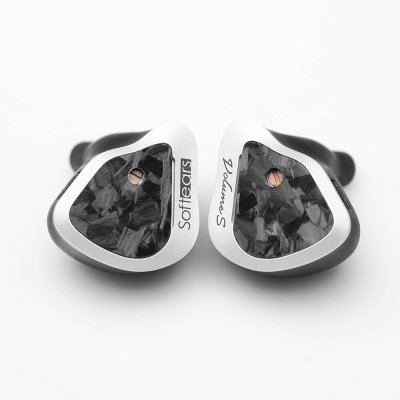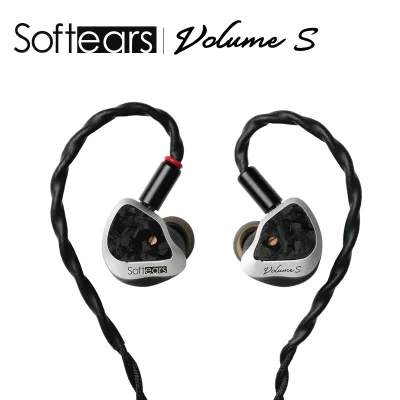Softears Volume S and Moondrop Blessing 3 use 2DD+2BA and 2DD+4BA driver setups respectively. Softears Volume S costs $320 while Moondrop Blessing 3 costs $320. Softears Volume S holds a clear 0.7-point edge in reviewer scores (7.8 vs 7.1). Softears Volume S carries a user score of 8.2. Softears Volume S has significantly better bass with a 1.6-point edge, Softears Volume S has better mids with a 0.8-point edge, Softears Volume S has better treble with a 0.9-point edge, Softears Volume S has significantly better soundstage with a 1-point edge and Moondrop Blessing 3 has better details with a 0.7-point edge.
Insights
| Metric | Softears Volume S | Moondrop Blessing 3 |
|---|---|---|
| Bass | 8.3 | 6.6 |
| Mids | 7.5 | 6.7 |
| Treble | 7.5 | 6.6 |
| Details | 6.5 | 7.2 |
| Soundstage | 8 | 7 |
| Imaging | 6.5 | 6.5 |
| Dynamics | 6 | 6 |
| Tonality | 7.9 | 6.6 |
| Technicalities | 7.5 | 7 |
Softears Volume S Aggregated Review Score
Average Reviewer Scores
Average Reviewer Score:
7.8Strongly Favorable
Moondrop Blessing 3 Aggregated Review Score
Average Reviewer Scores
Average Reviewer Score:
7.1Generally Favorable
Reviews Comparison
Softears Volume S reviewed by Super* Review
Youtube Video Summary
The Softears Volume S at $320 sets a new tonal benchmark for IEMs in its price range. It arrives in solid packaging featuring a zippered carry case (a bit large but functional), protective earpiece pockets that might feel overkill for some, and two excellent sets of ear tips – including Softears' own highly-regarded Ultra Clear tips. Build quality is generally fantastic, highlighted by a resin shell, a comfortable paracord-style cable with a low-profile, user-swappable termination system, and recessed 2-pin connectors. While the aesthetics might feel a bit old-school to some, the fit is comfortable and stable due to its semi-custom shape and longer nozzle, making it secure enough for sleeping. A small screwdriver-adjustable tuning switch offers a secondary, brighter Harmon-like sound signature, though the default tuning is preferred.
The default sound signature is a warm-tilted neutral, delivering exceptional natural timbre and tasteful bass boost. This bass stands out for its exceptional physicality – punchy and impactful without being overbearing – alongside articulate sub-bass that’s easy to follow. Combined with well-defined transients, particularly in the upper-midrange, it creates a satisfyingly rich and dense presentation. While spatial effects and imaging are competent but not standout, the overall tonality and bass quality are remarkably refined. Comparisons show it offers a better tonal balance and bass control than the bassier Dunu DaVinci, significantly more body and richness than the brighter, thinner Moondrop Blessing 3, and trades blows with the Moondrop Dusk – the Volume S providing superior density and mid-bass presence versus the Dusk's more open, spacious presentation.
Ultimately, the Softears Volume S earns a full five-star rating. It might not be the absolute most technically dazzling IEM, but its fantastic tonal balance, unique bass physicality, and overall refinement make it a compelling choice. For $320, it delivers a sound signature that feels just right – rich, satisfying, and universally appealing – challenging more expensive offerings and establishing itself as a top contender in its class.
Super* Review original ranking
Super* Review Youtube ChannelBuy Softears Volume S on HiFiGO
Ad
Price: $290
Buy Softears Volume S on HiFiGO
Moondrop Blessing 3 reviewed by Super* Review
Youtube Video Summary
Moondrop Blessing 3 sticks to the family recipe—clean, neutral, vocal-centric—while fixing the Blessing 2’s soft spot: treble extension. Cymbals finally have proper metallic sheen and decay, and the overall imaging/separation step up. Bass comes from a dual-DD setup that favors control over quantity: tight, springy, and articulate in the sub-bass without turning the set “bassy.” Vocals are outstanding for the price—transparent, textured, and front-and-center. Physically, it’s the familiar large 3D-printed acrylic shell with a slimmer ~5.7 mm nozzle for easier tip fit, glossy metal faceplates that love fingerprints, an improved but still slightly memory-prone cable, a chunky case, and lots of tips (but no Spring Tips). Price stays put at $320.
The one nitpick: a noticeable upper-bass/lower-mids scoop that trades warmth and body for clarity. With modern productions that already carry sub-bass, the presentation feels deep and precise; with leaner acoustic or classic rock, it can read a touch sterile. Versus peers: Blessing 2 is a hair warmer and fuller but less extended up top; Blessing 2 Dusk shares the mid scoop, adds more sub-bass, and keeps the older treble quirks; Soft Ears Studio 4 is similarly lean-neutral with a bigger stage but smoother BA timbre; Kiwi Ears Orchestra Light is warmer, punchier in mid-bass, and more laid-back with weaker separation. Even with the tonal quibble, this is a clear upgrade—a “nearly perfect” neutral set and an easy 5/5.
Super* Review original ranking
Super* Review Youtube ChannelBuy Moondrop Blessing 3 on Aliexpress
Ad
Price: $579
Buy Moondrop Blessing 3 on Aliexpress
Softears Volume S reviewed by Jaytiss
Jaytiss Youtube Channel
Moondrop Blessing 3 reviewed by Jaytiss
Youtube Video Summary
The Moondrop Blessing 3 is a 2DD + 4BA hybrid with a larger, premium-feeling shell that remains surprisingly comfortable—though size could be an issue for smaller ears. Accessories and build echo Moondrop’s recent releases (even the analog cable mirrors the Dusk’s), underscoring a cohesive design philosophy. Tuning skews a touch brighter and more analytical: airy upper-mids/treble, crisp detail retrieval, and clean separation, with lighter bass impact than some rivals. It’s a set that showcases “technicalities” in an immediately noticeable way.
Against the Crinacle x Moondrop Dusk, Blessing 3 trades some punch and warmth for extra sparkle and detail; Dusk offers more bass, slightly calmer treble, and a touch more “slam,” while Blessing 3 sounds airier and more incisive. Versus Variations, the graphs are similar and they trade blows, but Variations’ bass advantage struggles to justify the higher price for most listeners. Compared to Moondrop’s more affordable options (e.g., Aria 2) and value picks like TruthEar Hexa or AFUL’s Magic One, Blessing 3 delivers a more refined treble presentation and step-up resolution, while some mid-fi competitors around ~$600 don’t clearly outpace it in engagement or detail.
Priced ~$330 (often on sale around $280), Blessing 3 sits at the sweet spot before diminishing returns hit hard. The trade-offs are clear: a touch bright, bass-light for those craving heft, and not the absolute value king next to Dusk—but as an airy, detailed, well-built daily driver, it’s easy to recommend. Final call: a strong A-—especially fitting for treble-heads and anyone seeking a clean, modern Moondrop tuning without paying flagship prices.
Jaytiss Youtube Channel
Softears Volume S reviewed by Gizaudio Axel
Gizaudio Axel original ranking
Gizaudio Axel Youtube ChannelMoondrop Blessing 3 reviewed by Gizaudio Axel
Gizaudio Axel original ranking
Gizaudio Axel Youtube Channel
Softears Volume S reviewed by
 Fresh Reviews
Fresh Reviews
Youtube Video Summary
The Softears Volume S delivers a fantastic hybrid sound in its low impedance mode, characterized as a warm neutral tuning with a lush note weight, good bass punch without bloat, and a slight upper-midrange emphasis that makes vocals pop. This signature translates exceptionally well across both music listening and competitive gaming, offering great separation, layering, and phenomenal imaging for precise positional awareness. While engaging and non-fatiguing, gunfire and intense effects in games like Apex Legends can sometimes feel on the verge of shouty or slightly occlusive during chaotic, high-level scenarios, lacking that last bit of air and resolution in the upper mids.
Gaming performance shines across multiple titles. The Volume S provides outstanding depth perception and accurate imaging for Apex Legends slides and light footsteps, excels in Valorant with its separation and verticality, handles the chaos of Call of Duty exceptionally well, and proves to be a top recommendation for Fragpunk due to its loud, precise, and easily trackable footsteps. The smaller resin chassis offers great comfort and ergonomics, especially for those struggling with fit, though it doesn't feel quite as premium as some metal competitors in its price range.
Significant drawbacks include the utterly dismissed high impedance mode tuning, deemed "absolute garbage" and a headache for gaming, and the fragile tuning mechanism itself, prone to easy damage. The included shoelace-style cable is functional with a removable termination but not a favorite, and the unboxing experience, while decent with a pleather case, extra termination, and two sets of silicone tips, is fairly typical for the price. Ultimately, the Softears Volume S stands as a killer all-around IEM when locked into its excellent low impedance mode, highly recommended for its crossover appeal despite the useless tuning switch and build quibbles.
Fresh Reviews original ranking
Fresh Reviews Youtube Channel
Moondrop Blessing 3 reviewed by
 Fresh Reviews
Fresh Reviews
Youtube Video Summary
Moondrop’s Blessing 3 pushes a distinctly airy, high-clarity take on competitive audio. The stage feels a touch farther from the head, with solid imaging, depth perception, and verticality, but it walks the edge of “how far is too far” for games like Valorant and Apex. Detail retrieval up top is crisp and separation of higher-frequency cues is clean, yet the set could use a bit more immediacy and extra sub-/mid-bass to weight deep thumps and footsteps. Once ears adjust, performance is strong, though the bright tilt can be fatiguing for some. The see-through shell with a metallic faceplate is slick; accessories are fine but basic at this price ($310), with tips and cable that invite swapping.
Against Dunu’s SA6 MK2, the Blessing 3 sits on the “open/bright” end while the Dunu plays “closer/warmer,” delivering more urgency from its fuller low end—but that extra mid-bass can blur layering and separation when many similar cues trigger at once. For pure game sense, both have Wallhack Certified potential, just not near the top; sets like Kiwi Ears Orchestra Light (V2) strike a smarter middle ground with better balance for mixed scenarios, and options such as Dunu Vulkan or Raptgo Hook-X can edge them out. Ergonomics are good on both; the SA6 MK2’s “Mini Hulk” cable and swappable plugs (4.4/2.5/3.5) and generous tip spread help justify its higher tag ($579). Summary: choose Blessing 3 for a brighter, wider, cue-separating presentation; choose SA6 MK2 for a nearer, meatier hit—while the Orchestra Light V2 remains the safer, game-first recommendation.
Fresh Reviews original ranking
Fresh Reviews Youtube ChannelSoftears Volume S reviewed by Jays Audio
Youtube Video Summary
The Softears Volume S emerges as a standout vocal specialist under $500, often described as a "mini studio 4“ due to similar frequency graphs. However, it trades some treble detail for superior scaling and a heightened focus on the mid-range, particularly vocals, while adding a touch more mid-bass oomph. This treble reduction allows the music to breathe, creating a more immersive and musical experience that pulls the listener deeper into the sound compared to the Studio 4, without sacrificing a sense of space or leaving the bass and treble feeling inadequate. Though not bass-heavy or treble-head oriented, the low-end provides enough thump and the highs enough air to avoid sounding lean or dark, resulting in a presentation that's slightly less technical and balanced than the Studio 4 but excels in vocal delivery and engagement.
A key feature is the tuning switch which boosts upper mids and treble while lowering the bass, effectively transforming the sound into a cleaner, more technical version of Harman 2019, even surpassing the Studio 4 in detail retrieval in this mode. However, this boosted configuration can sound shouty, lean, and overly clinical for many preferences, lacking the thickness of the stock tuning and scaling less effectively at higher volumes. The stock tuning, preferred for its vocal prowess, truly comes alive with increased volume. The included clear tips are recommended for a slight treble lift and comfort, and the bundled USBC adapter adds a subtle amount of sub-bass rumble, though the low-end remains clean and controlled, reminiscent of leaner sets like the Pilgrim, not providing heavy slam.
While the Studio 4 remains a solid, well-balanced all-rounder, especially on sale around $350, and alternatives like the EM10 (more detailed), Supermix 4 (better value), the Volume S carves its niche with exceptional vocal performance at higher volumes using the stock tuning. Its main drawbacks involve the confusing switch design (requiring opposite positions on each earpiece for the same tuning with no clear indicators) and the pricing debate; using non-branded drivers suggests a more appropriate price point would be $200-$250 rather than $300. Despite these quirks and marketing claims about the passive radiator's role (its actual impact being debatable), the Volume S delivers a great sounding, flexible IEM offering distinct sonic profiles based on volume level and switch position.
Jays Audio Youtube Channel
Moondrop Blessing 3 reviewed by Jays Audio
Youtube Video Summary
Moondrop Blessing 3 brings excellent resolution, clarity, and layering, with a clean, transparent tonality that skews bright-leaning neutral. Treble is extended without being splashy, giving plenty of air to cymbals and female vocals, while the midrange stays unmasked and articulate—piano and guitar transients pop with crisp decay. Staging is open and airy with pinpoint imaging (not wrap-around holographic like the biggest stage monsters), and the bass is snappy, tight, and bleed-free. The catch: the low end sits back, so on certain tracks the presentation can feel light, and a 6 kHz rise can get spicy at louder volumes depending on the song; vocals may lean a touch thin in classic Moondrop fashion.
Compared to Blessing 2, it’s a clear step up in cleanliness, note definition, and separation. Versus Dusk, think side-grade: a slightly brighter tilt and less bass weight, trading some low-end texture/extension for more air and edge definition. The set responds very well to EQ—a ~+5 dB low shelf @ 60 Hz (Q 0.5) and about −1.5 dB @ 6 kHz (Q 3) adds punch and reins in glare; with this, it approaches Variations performance while filling in mid-bass a bit. Simple nozzle filters (e.g., Alina/Tanchjim-style) can also tame upper mids and nudge bass up. For listeners who want more slam and tamer highs, stock tuning won’t be the endgame; for those preferring a clean, airy, detail-forward neutral, Blessing 3 is pretty banging at its price and technically competitive with pricier sets (think RS5, Oracle, even EGL7M on technicals, though the latter still stages wider). If Moondrop’s house sound clicks, it’s an easy rec; if not, look at cheaper options like Hexa or keep an eye out for a potential B3 “Dusk” variant.
Jays Audio Youtube Channel
Softears Volume S reviewed by Z-Reviews
Youtube Video Summary
The Softears Volume S offers a dramatic transformation through its impedance switch, requiring a tiny screwdriver to toggle between low (9.8 ohm) and high (31.2 ohm) modes. The low impedance mode is described as painfully clinical, bland, and annoyingly sterile across all tested amplifiers. It’s reminiscent of the disliked original Volume model, lacking any enjoyable tuning despite EQ attempts. This mode only suits listeners craving absolute neutrality, offering little musical engagement.
Switching to the high impedance mode completely revolutionizes the experience. It becomes relaxed, unoffensive, and remarkably smooth, with notes possessing a lingering, church-like resonance that adds emotional depth. This mode presents music with a spacious, uplifting quality and a subtle chest-felt pressure during resonant passages. However, it demands quality amplification to shine and benefits from tip-rolling; the included sticky liquid silicone tips enhance the signature, though alternatives like Azla SednaEarfit can tweak the response. Comfort and build are excellent, though the fabric cable exhibits some microphonics.
Priced around $300, the Volume S earns a cautious recommendation primarily for its stellar high-impedance performance. It requires tinkering with tips and sources to reach its potential and faces stiff competition in its price bracket. While not an outright class leader, it’s a significant upgrade over the original Volume. The package includes a luxurious case, multiple tips, and a branded USB-C adapter, reflecting Softears' typical attention to detail. Just keep it locked in high-impedance mode.
Z-Reviews Youtube Channel
Moondrop Blessing 3 reviewed by Z-Reviews
Youtube Video Summary
Moondrop Blessing 3 ditches the old vibe for a fresh hybrid recipe: H.O.D.D.U.S. (two horizontally opposed 10 mm dynamics) plus 4× BA at around $320. The stage isn’t huge, by design—this is an intimate, in-the-head presentation that puts the music right up front. Bass is quick, tight, and more about responsiveness than brute slam; treble is crisp without splash, and nothing feels exaggerated. The crossover is impressively cohesive—no obvious handoff between DDs and BAs—yielding a “mixing/mastering” sort of neutrality with excellent detail retrieval and control. Think subtle-but-capable: delicate when it should be, instantly punchy when it must.
Build is peak Moondrop showpiece—shiny stainless backplate, clear acrylic shell showing the guts, and a comfy fit—but the stock 3.5 mm cable is underwhelming. The box is over-engineered fun; the tips selection is one silicone type in many sizes (foam not ideal here). Tip rolling to something like Dunu S&S keeps bass honest. Amp pairing prefers clean, linear gear; warm hybrids can push mids oddly, while neutral solid-state keeps things balanced. Not hard to drive (~12 Ω). Skip if you crave gobs of soundstage; absolutely grab if the goal is a neutral, close-up, fast, and coherent listen that “force-feeds” the music—without the fatigue. A confident buy for presence and precision.
Z-Reviews Youtube Channel
Softears Volume S reviewed by Tim Tuned
Youtube Video Summary
The Softears Volume S delivers a distinctly colored sound signature with significant boosts in two key areas: the bass and the upper mid-range. Its bass profile is uniquely elevated up to around 300Hz, resulting in a physical, heavy, yet well-defined low end that impresses with substantial note weight and attack, appealing even to bass enthusiasts. Vocals cut through clearly due to the upper mid-range boost, but this tuning comes with a trade-off: a noticeable sense of hollowness and a narrower soundstage that can feel congested on certain tracks, creating a love-hate relationship with its presentation.
The treble offers a safe, natural, and polite character, providing adequate detail without excessive brightness or roll-off, though it may lack sparkle for some listeners. Technically, the Volume S performs at a level comparable to the Moondrop Blessing 3, excelling particularly in the incisive attack and substantial weight behind each note. When compared to competitors, the Volume S edges out the Tea Pro in bass quality, separation, and natural timbre, though the Tea Pro offers a wider stage. Against the Blessing 3, the Volume S trades openness and cleanliness for a more fun, bass-forward and impactful experience. It also presents a more balanced signature than the brighter, more treble-focused Kiwi Ears Astral.
Ultimately earning an A-minus rating, the Volume S is highly recommended for those seeking exceptional bass quality and a fun, colored tuning. However, it might not suit listeners prioritizing a wide soundstage, a neutral signature, or a bright, sparkly treble with forward micro-details; these listeners are advised to audition first.
Tim Tuned Youtube Channel
Moondrop Blessing 3 reviewed by Tim Tuned
Youtube Video Summary
Moondrop Blessing 3 steps up as the most complete Blessing yet—cleaner and more controlled than the Blessing 2: Dusk, with less bass quantity but sharper dynamics and a tidier lower-midrange. It avoids the slight thinness some hear on Variations, keeping notes lean but satisfying. The midrange stays beautifully natural and a touch energetic without shout, while the biggest upgrade is in the treble: retaining the Dusk’s natural decay yet adding more air, so micro-details pop and vocals take center stage. The overall tilt is more vocal-forward and detail-focused than Dusk.
On the technical front, resolution sits around—or a notch above—the Timeless, with an impressively wide stage helped by reduced bass bleed and boosted upper air. Micro-detail is present but not laser-etched; separation could use that last half-step of incisiveness. Still, imaging, control, and clarity make for an easy “wow” on first listen, especially for listeners who value clean layering over sheer slam.
Comparisons are straightforward: versus the original Blessing 2, this is an upgrade across the board—cleaner lows, punchier bass quality, better lower-treble timbre, and comparable air. Versus Blessing 2: Dusk, choose Dusk for a more balanced and fuller bass hit; pick Blessing 3 for vocal presence, detail, and control. Against SoftEars Studio 4, Studio 4 sounds about a half-step more balanced with a touch more bass fullness and slightly better timbre, but the Blessing 3’s performance at roughly $320 is seriously competitive for the class. After a few underwhelming Moondrop releases, this feels like reclaiming the throne—a highly recommended return to form.
Tim Tuned Youtube Channel
Softears Volume S reviewed by Head-Fi.org
Moondrop Blessing 3 reviewed by Head-Fi.org
Softears Volume S (more reviews)
Softears Volume S reviewed by Audio Amigo
Youtube Video Summary
Softears Volume S follows the 2022 Volume and steps into a fiercely competitive ~$320 bracket with a seriously premium kit: a gorgeous leather case, modular screw-on terminations, both standard and Ultra Clear eartips, IM booties, and tiny screwdrivers for the on-board potentiometer. The stealthy black resin shells with exposed carbon-fiber faceplates feel solid and fit well thanks to slim nozzles; just note there’s no nozzle mesh. The big caveat is the cloth-sheathed stock cable—ergonomically nice but with heavy microphonics. Two tunings are selectable: low-impedance (≈10Ω) and high-impedance (≈31Ω). The low-impedance mode is the keeper; it’s easy to drive yet sensitive to source output impedance, so a dongle under 1Ω is recommended to avoid unintentionally shifting the tonality.
In low-impedance mode the signature is neutral-natural, a flatter, more mid-centric take on “new-meta.” Bass offers quality over quantity: textured, punchy, and responsive without tipping into basshead territory. The mids are the star—clean, warm-tinged lower mids give male vocals body while female vocals sit forward without shout, keeping timbre natural. Treble is smooth, airy, and non-fatiguing, avoiding metallic glare while preserving sparkle. Technical performance is confidently above average for the price: imaging & stage feel wide and well-layered, with good separation and resolution that rewards attentive listening without forcing it.
Positionally, think “Kato upgrade”: smoother treble, better bass texture, and a refinement that many will prefer. Versus spicier rivals like DaVinci, Project Meta, Dusk DSP, or Mega 5 EST, the Volume S sounds more controlled and “correct,” trading some slam and upper-air fireworks for coherence and timbre. It won’t thrill bass lovers, treble heads, or detail chasers seeking a spotlighted presentation; everyone else gets a superb all-rounder that feels benchmark-worthy—the HD600/650 vibe for IEMs. Verdict: you should buy this if a do-it-all, neutral-natural tuning is the goal; just mind your source impedance and consider swapping the cable to kill the microphonics.
Audio Amigo Youtube Channel
Softears Volume S reviewed by Audionotions
Softears Volume S reviewed by Smirk Audio
Moondrop Blessing 3 (more reviews)
Moondrop Blessing 3 reviewed by Shuwa-T
Moondrop Blessing 3 reviewed by Yifang
Youtube Video Summary
Moondrop Blessing 2:Dusk brings a rock-solid build with clear acrylic shells that show off the 1DD+4BA internals and that cheeky anime engraving. Fit skews large—big nozzles and a bulky body—so smaller ears may struggle. The included “sweat guards” are basically stickers that tend to come off with the tips, and taking these to the gym is a bad idea (moisture can cause issues). The real sin is the stock cable: thin, microphonic, and fragile—swap it immediately. On the upside, customer service/warranty is legit if something goes wrong.
Sonically, this tuning is a crowd-pleaser. The bass extends deep for a DD and slams without bleeding, the mids are the highlight—acoustic instruments and vocals sound fantastic—and the treble is clean but can push toward fatigue for sensitive listeners or on bright EDM drops. For electronic genres (hardstyle, D&B), the low-end grip is addictive; for orchestral and vocal music, it’s as close to “set and forget” as it gets. Quick fix if the top end nudges too hot on desktop: a simple EQ cut—~−4.5 dB @ 8 kHz (Q≈1)—tames the edge and lets the volume come up for extra bass satisfaction.
Technical chops are strong: resolution pops micro-details without turning clinical, soundstage width sits in the higher percentile for the price, and dynamics swing convincingly from soft to slam. Imaging is fine, but positional distance (for Valorant/CS-style footsteps) isn’t the strength—Apex/Overwatch or media use is totally fine. Net takeaway: as an everyday all-rounder for music, games, and movies around this bracket, it’s a killer pick with just two caveats—skip the stock cable and avoid sweaty workouts—or EQ the treble if sensitive.
Yifang Youtube Channel
Moondrop Blessing 3 reviewed by Precogvision
Precogvision Youtube Channel
Moondrop Blessing 3 reviewed by Nymz
Softears Volume S Details
Driver Configuration: 2DD+2BA
Tuning Type: Neutral with Bass Boost
Brand: Softears Top Softears IEMs
Price (Msrp): $320
Support our free service! Buying through our affiliate links costs you nothing extra:
Moondrop Blessing 3 Details
Driver Configuration: 2DD+4BA
Tuning Type: Neutral
Brand: Moondrop Top Moondrop IEMs
Price (Msrp): $320
Support our free service! Buying through our affiliate links costs you nothing extra:
Softears Volume S User Review Score
Average User Scores
Average User Score:
Based on 2 user reviews
8.2Very Positive
Moondrop Blessing 3 User Review Score
Average User Scores
Average User Score: n/a
Based on 0 user reviews
No user reviews yet. Be the first one who writes a review!
Softears Volume S Gaming Score

Gaming Score & Grade
- The gaming score is prioritizing technical capabilities of the IEM (Separation, Layering, Soundstage) and good value.
Gaming Score
8.4Gaming Grade
A+Moondrop Blessing 3 Gaming Score

Gaming Score & Grade
- The gaming score is prioritizing technical capabilities of the IEM (Separation, Layering, Soundstage) and good value.
Gaming Score
6.8Gaming Grade
B+Softears Volume S Scorings
Average Technical & Tuning Grades
Average Tunign Grade
A- Tuning feels well executed, keeping a natural flow across the spectrum. Switching genres feels seamless.
Average Technical Grade
A- You get a well-rounded technical package that keeps separation, detail, and staging in harmony. It's a solid middle ground between fun and fidelity.
Moondrop Blessing 3 Scorings
Average Technical & Tuning Grades
Average Tunign Grade
B+- Expect a friendly tonal balance that could use polish but remains inviting. Great for casual listening, less so for purists.
Average Technical Grade
A-- Overall technicalities are acceptable, delivering enough clarity for casual sessions. Imaging is serviceable though not immersive.
Softears Volume S User Reviews
Share your experience and build your personal ranking list.
You need to be signed in to write your own reviewA well-rounded, coherent IEM that shines in low-impedance tuning with excellent midrange clarity.
Pros
Balanced, natural midrange with solid bass and rich accessories.Cons
High-impedance mode feels unnecessary and shells may be bulky for small ears.RSV with more bass quantity and better quality, at less than half the price.
Pros
Very nicely balanced sound signature for all-rounder duties, with tonality and technical performance that punches above its price. More even sub - mid bass profile which results in a more cohesive, better textured bass vs harman/meta tuned sets.Cons
Pinna gain isn't an ideal fit for my HRTF, hearing slightly too much upper-mid emphasis after extended listening and comparisons. Upper treble is lacking air vs more expensive sets, most evident in cymbal hits coming across dulled, not unlike the RSVMoondrop Blessing 3 User Reviews
"This is an example review"
Pros
- Example pro 1
- Example pro 2
Cons
- Example con 1
- Example con 2
Share your experience and build your personal ranking list.
You need to be signed in to write your own reviewFind your next IEM:
IEM Finder Quiz
newIEM Comparison Tool
newVS
































